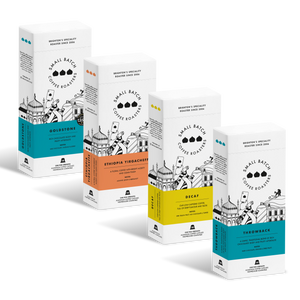Taste the Difference: A Fun Guide to Developing Your Coffee Palate
Jun 18, 2025
 Ever wondered how coffee pros taste and evaluate coffee? Enter cupping, the sensory ritual used by roasters and baristas to assess coffee flavour, aroma and quality. Think of it as a wine tasting, but with beans instead of grapes. And yes, it’s totally caffeine-fuelled yet alcohol-free fun.
Ever wondered how coffee pros taste and evaluate coffee? Enter cupping, the sensory ritual used by roasters and baristas to assess coffee flavour, aroma and quality. Think of it as a wine tasting, but with beans instead of grapes. And yes, it’s totally caffeine-fuelled yet alcohol-free fun.
At Small Batch Coffee Roasters in Brighton, we cup coffees weekly, sometimes even multiple times per week, to explore flavour, quality and consistency. Why so often? Because coffee is a plant, and like any natural product (think of how flowers smell different day to day), it evolves constantly. A bean’s flavour can shift over time depending on how it’s stored, roasted, or simply as it ages. Factors like exposure to oxygen, moisture or light can subtly change a coffee’s profile. Seasonality also plays a big role, fresh harvests taste different to older ones, and different crops come in at different times of year. We taste every new coffee we bring in, and we cup every delivery for our blends to monitor for changes. If something tastes slightly different, we may adjust the roast profile or the blend itself to keep the flavour just right. At Small Batch taste and quality are essential to every cup we brew.
How to Cup Coffee at Home
You don’t need a lab coat or a teeny tiny beanie to cup coffee. Here’s how to recreate the pro experience at home whether solo or with your mates.
What You'll Need:
-
Whole bean coffee (or ground to order for your chosen brewing method)
-
Scales
-
Kettle (96°C water - boil and then let it cool for a few minutes)
-
200ml bowls or glasses
-
Spoons
-
Timer
Step-by-Step Guide:
-
Grind: Medium-coarse, like rough sand. Use 12g per 200ml of water. (If ordering Small Batch Coffee, and you need it ready ground, selected 'cafetiere' for your grind size)
-
Smell the dry grounds: This is your first aromatic impression.
-
Brew: Pour hot water evenly over the grounds. Start your timer.
-
Crust and aroma: At 4 minutes, break the crust with a spoon and inhale deeply.
-
Slurp: Skim the surface, then slurp from a spoon to spray the coffee across your palate. To be a true professional, make a loud slurping sound like you're sucking up ramen noodles.
-
Repeat with all your chosen coffees! Make sure to clean the spoon in hot water after each taste.
What to Look (and Taste) For
Use these key elements to guide your tasting:
-
Aroma: What does it smell like; floral, nutty, spicy?
-
Flavour: Identify tasting notes. Think berries, citrus, chocolate, stone fruit.
-
Acidity: Bright like an apple? Or soft like plum?
-
Body: Light like tea, or heavy and syrupy?
-
Balance: Do all parts of the flavour feel in harmony?
-
Finish: What flavours linger after swallowing?
Understand the Coffee Behind the Cup
-
Origin: African coffees (e.g. Ethiopia, Kenya) are often fruity and floral. Central and South American beans tend to be chocolatey, nutty or caramel-like.
-
Altitude: Higher-grown coffees usually have more acidity and clarity.
Processing: -
Washed: Clean, crisp.
-
Natural: Fruity, winey, bold.
-
Honey: Balanced, sweet, complex.
Roast Level: -
Light: Bright and delicate.
-
Medium: Balanced.
-
Dark: Bold, roasted, often smoky.

Make It a Game: Host a Coffee Tasting Night
Turn your cupping into a group activity! Try a blind tasting and score each other on:
-
Identifying origins
-
Guessing flavour notes
-
Rating body, acidity and finish
Crown your Coffee Connoisseur and compare tasting notes. It’s a brilliant way to sharpen your palate and discover what you love in a brew. Want a FREE score sheet and quiz designed by Small Batch? Download one HERE, we’d love to see your coffee tasting nights, don’t forget to tag us on socials at @SmallBatchCr



